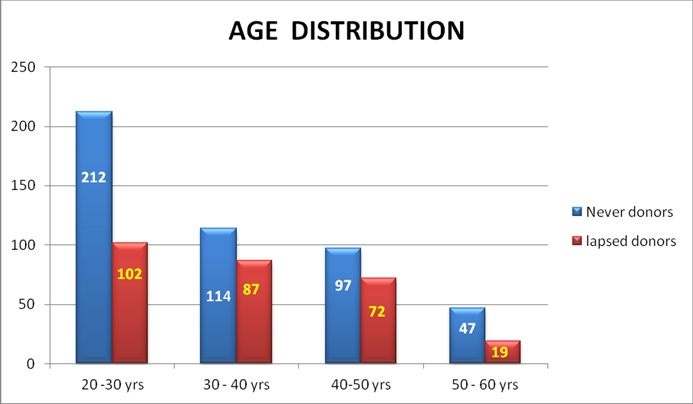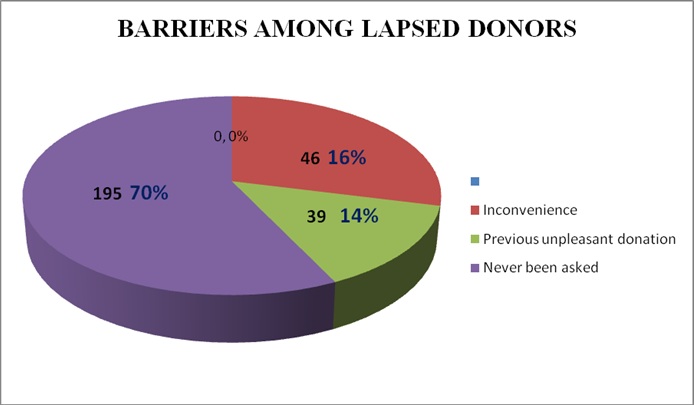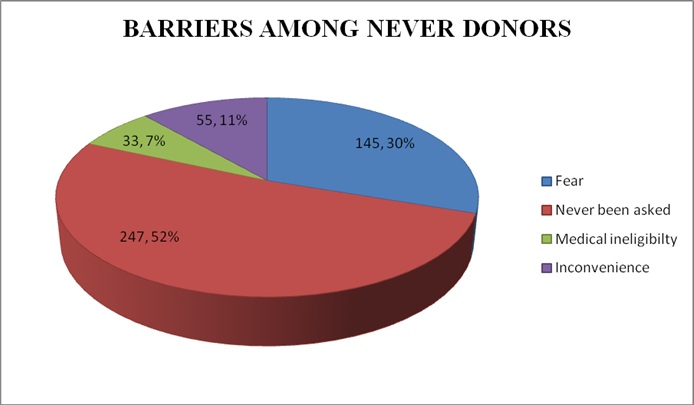Opinions about Blood Donation amongst Medical Personnel’s
Joshua Daniel M.1, Prakash H. Muddegowda2, Dhivya K.3, Aswin Kumar S.4, Arun R.5, Subash S.6, Krishnamoorthy R.7
1 Assistant Professor, Department of Transfusion Medicine, VMKV Medical College, Salem, Tamilnadu, India.
2 Associate Professor, Department of Pathology, VMKV Medical College, Salem, Tamilnadu, India.
3 Post-graduate, Department of Transfusion Medicine, VMKV Medical College, Salem, Tamilnadu, India.
4 Post-graduate, Department of Transfusion Medicine, VMKV Medical College, Salem, Tamilnadu, India.
5 Assistant Professor, Department of Transfusion Medicine, Shri Venkateswara Medical College, Tirupathi, Tamilnadu, India.
6 Assistant Professor, Department of Transfusion Medicine, Institute of child Health, Chennai, India.
7 Assistant Professor, Department of Transfusion Medicine, SRMC, Chennai, India.
NAME, ADDRESS, E-MAIL ID OF THE CORRESPONDING AUTHOR: Dr. Prakash H.M., Associate Professor, Department of Pathology, VMKV Medical College, Salem, Tamilnadu, India.
Phone: 9751439069,
E-mail: medicoprakash@gmail.com
Objective: There is limited literature in the Indian subcontinent on the attitude of the medical personnel regarding blood donation. The purpose of the present study was to identify and assess the barriers that prevent people from becoming blood donors and also to devise recruitment strategies to increase the blood collection.
Materials and Methods: This study was conducted in a tertiary care centre with attached medical college in Tamilnadu amongst 750 medical personnel. A self administered questionnaire was used for data collection from each individual.
Results: Amongst the 750 medical personnel under study, 470 were never donors and 280 were lapsed donors. The foremost reason for not donating blood among lapsed donors and non donors was never being asked again.
Conclusion: Donors often donate blood once and rarely return to make a second or subsequent donation. Further education, motivation and dissemination of information would help in recruitment and retention of non-remunerated blood donors.
Blood collection, Blood donation, Medical personnel
Introduction
“Safe blood starts with me, blood saves lives.” was the WHO theme for 2000 AD. Globally, the demand for blood products in India is projected to increase substantially in coming years and many people die every year due to insufficient supply of blood and its components. The substantial challenges include population growth and population ageing endangering the supply of adequate blood supplies in the coming years. There is a considerable shortage even in the metropolises with the supply being 50% less than the recruitment. The problem is further compounded by inappropriate use of blood without separation into its components in the peripheral setups [1,2].
In India the total number of blood banks are 2,609 - government blood banks are 940, voluntary blood banks are 376, private/ hospital attached blood banks are 753, and charitable/trust blood banks are 540. The annual collection was around 8.1 million units last year while the requirement is around 10 million units. Mass media (media print, radio, television, sms, internet) helps create an awareness of need of safe blood by eliminating misunderstanding, mobilize opinion in favour of blood donation and also building trust and confidence [3].
Participation decline is well documented in literature with potential causes which include reduced altruism, increased deferrals, and a decreased donor pool. Donor recruitment and retention needs to be increased to address this growing requirement. Improving the retention of donors offers an opportunity to leverage this availability of blood products. Creating and maintaining a safe sustainable pool to meet utilization needs is a challenge for blood centers all over the world [4,5].
Healthy blood supply is important for blood transfusion, which otherwise would affect the health of target population (recipients). Inviting and maintaining low risk population groups for voluntary and consistent blood donation is the most important management strategy of world blood transfusion centers. So having constant knowledge from satisfaction level, awareness, and attitudes of each of the beneficiaries is essential. Thus, existence of a collective effort by blood transfusion organization to increase number of people who donate regularly blood is required and needs to be planned appropriately [1,4,6].
Medical personnel can be a very good source of quickly accessible, quality blood if they are motivated and are willing to be voluntary blood donors [4]. This study was conducted to identify and assess the barriers that prevent people from becoming blood donors and increase the total blood collection.
Materials and Methods
This prospective study was conducted in a tertiary care centre with attached medical college in Tamilnadu, India from January 2012 to July 2012 among 750 medical personnel which included Consultants, teaching and non-teaching faculty members, post graduates, MBBS students, nursing staffs and paramedical personnel representing both the sexes and of different age groups (20-55). The respondents were given briefing on the aims of the study and they were ensured about confidentiality by one of the authors. Ethical committee consent was taken from the institution.
Statistical Analysis
Descriptive statistics was used in the study and was done using SPSS version 18.
Results
Amongst the 750 medical personnel 470 were never donors (305 males and 165 females) and 280 were lapsed donors (238 males and 42 females). Males were dominant in both groups. The ages of all the donors were within the standard age of 18-60 with the predominant population being that of 2-3rd decade (87%) [Table/Fig-1].
Showing age distribution of never and lapsed donors

The foremost reason for not donating blood among both lapsed donors and never donors was never being asked again, other reasons among lapsed donors included time inconvenience or previous unpleasant donation. The qualification of the personnel under study included consultants (8%), post graduates (20%), undergraduate students (42%), nursing staff (28%) and paramedical personnel (2%).
Barriers among lapsed donor and non donors are as shown in [Table/Fig-2 and 3] respectively.
Showing reasons for barriers among lapsed donors

Showing reasons for barriers amongst never donors

Only 12% of the study population agreed with the constant need for blood in hospitals.
Discussion
Blood is always in demand. A disaster, natural or man made suddenly increases the demand for blood. Worldwide surgery, trauma and cancers (annually 234 million major operations, 63 million trauma induced surgeries, 31 million cancer treatments, and 10 million pregnancy related complications), which require transfusions, are replacing communicable diseases as leading causes of death. This study was done to assess the attitudes of donor and non donors in the medical fraternity about blood donation.
Multiple studies have identified various causes for donor and non-donors behavior towards blood donation which included positive attitudes like an act of god, to help people, and maintaining of their health. Negative attitudes included not being asked, fear of catching infectious diseases, lack of time, lack of easy access to donation sites, poor knowledge, perceptual beliefs, fear of developing medical problems like anemia, satisfaction rate from last donation with loss rate (inverse relationship), previous exemption, dizziness and feeling faint [2,6–8]. In our study, not being asked, fear of needle, previous unpleasant donation, medical ineligibility and inconvenience were the main causes.
Studies among physicians have shown high knowledge with regard to blood groups and transmissible infections by blood. There are several wrong perceptions amongst the non-medical but educated people, which includes gaining weight, loss of virility, weakness, infections compared to the medical people. Medical people are worried more about the requirement of blood for the dear ones in the near future and the needle prick injury complications. Time is also a factor as the tight schedule does not allow one the time to donate blood. Definite provisions need to be given for the medical personnel to promote blood donation along with increased awareness of the importance of their blood donation [1,4].
Maximum number of non-donors (both medical and paramedical) in the study stated the reason of their non-donation being “no one has ever asked them to donate blood”. This was surprising as they usually request for blood and blood components and implies that even the increased level of awareness on the subject does not result in actual act of donating blood. It would, therefore, not be justified to expect from general public “humane gesture of preserving life” without creating in them awareness of the importance of voluntary blood donation. Other study also showed similar cause [9].
Blood collection agencies should increase awareness that blood donation is a worthwhile and important volunteer activity. Another strategy would be to capitalize on the existing perception that donating blood is like donating money or used clothing, by focusing on the concept of giving something tangible. Along with providing convenient opportunities to donate, blood centers need to effectively convey the need for blood and allay fears about the donation process to increase the current donor pool [4,6,7,9,10].
Incentives for donating blood is present all over the world includes few days leaves, marks, etc. [1]. In India certificates are provided as an appreciation. Other incentives are necessary.
Medical personnel are a potential pool of safe voluntary donors and needs to be harnessed actively to achieve sustainable blood banking system of 100% voluntary donors as targeted by World health organization. The medical personnel once recruited in pool can also be used as in-house donors, who will meet the demand of non-availability or emergency scenarios [11].
NGO services like National service scheme, Red cross, Youth clubs, actively participate in blood donor motivation campaigns and blood donation camps. They help in organization of blood camps on national holidays, world blood donors day, leaders birthdays and during festival seasons and also by mobile blood collection at common places of gathering like beaches, etc.
Conclusion
This study shows a loss of one of the important group of repeat voluntary blood donors and the need to not only establish but also maintain this nearest donor pool. The significant findings of the study included less awareness about the importance of donation amongst medical personnel and effort should be increased towards recruitment and retention of voluntary non-remunerated blood donors through education and awareness programmes at all levels. Further studies about awareness, incentives are needed to establish the recruitment programmes for this pool.
[1]. Alam M, Talha M, Ahmed S, Perceptions about blood donation among army personnelPAFMJ 2006 3:311-5. [Google Scholar]
[2]. Siddiqui UF, Yasmeen A, Hina N, Alam SN, Who donates more; medical or non-medical StudentsJournal of Dow University of Health Sciences Karachi 2012 6(1):17-21. [Google Scholar]
[3]. Sujith D, Overview of scenario of blood donation of different states in IndiaIn: National conference and workshop on strategies for blood donor recruitment and total voluntary blood programme Jan 23-25 2010 KolkataAssociation of voluntary blood donors, West Bengal, India 2010Available at http: http://www.angelfire.com/sc3/subrata/ProcPart1.pdf [Google Scholar]
[4]. Bharatwaj RS, Vijaya K, Rajaram P, A descriptive study of knowledge, attitude and practice with regard to voluntary blood donation among medical undergraduate students in pondicherry, IndiaJournal of clinical and diagnostic research 2012 6(4):602-4. [Google Scholar]
[5]. Kanner WA, Jeffus S, Wehrli G, An academic-based hospital donor site: Do physicians donate blood?Annals of clinical and laboratory science 2009 39(4):339-44. [Google Scholar]
[6]. Fekr FR, Effective factors on willingness to donate bloodIJCRB 2012 4(7):677-82. [Google Scholar]
[7]. Butler AJ, Assessing the effects of donor knowledge and perceived risk on intentions to donate bloodJ health care mark 1993 13(3):26-33. [Google Scholar]
[8]. Masser Barbara M, Barbara W, Katherine M, Katherine H, Melissa K, The psychology of blood donation: Current research and future directionsTransfusion medicine reviews 2008 22(3):215-33. [Google Scholar]
[9]. Gilani I, Kayani ZA, Atique M, Knowledge, attitude and practices (kap) regarding blood donation prevalent in medical and paramedical personnelJ Coll Physicans Surg Pak 2007 17(8):473-6. [Google Scholar]
[10]. Mathew SM, King MR, Glynn SA, Dietz SK, Caswell SL, Schreiber GB, Opinions about donating blood among those who never gave and those who stopped: a focus assessment groupTransfusion 2007 47(4):729-35. [Google Scholar]
[11]. Benedict N, Usimenahon A, Alexander NI, Isi A, Knowledge, attitude and practice of voluntary blood donation among physicians in a tertiary health facility of a developing countryIJBTI 2012 2:4-10. [Google Scholar]